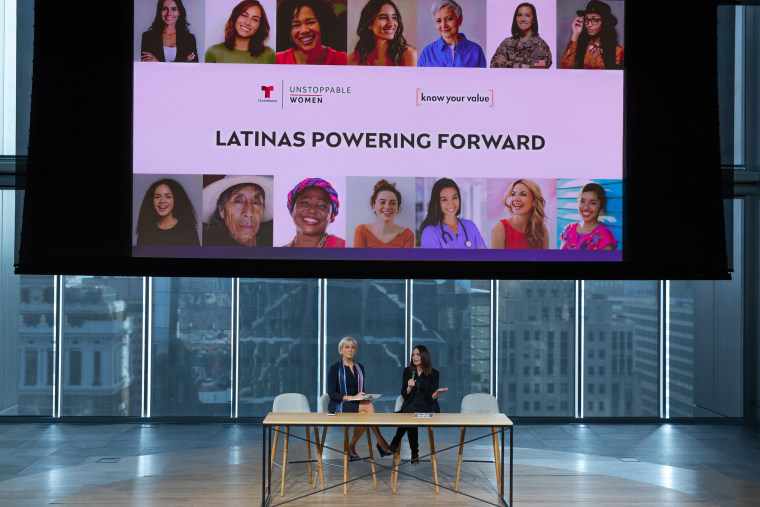On Nov. 20, women are marking Latina Equal Pay Day, which signals the 23 months it takes for Latinas to catch up to the annual earnings of their white, male counterparts from the year before.
“The reality is that Latina women are still making 54 cents for every dollar that a non-Hispanic white male makes,” said Monica Gil, chief marketing officer and executive vice president for NBCUniversal Telemundo. “So we have a lot of work to do.”
She made the remarks during an interview with “Morning Joe” co-host Mika Brzezinski and millennial contributor Daniela Pierre-Bravo Tuesday at a Know Your Value event in Philadelphia.
Gil is involved in Telemundo’s Unstoppable Women campaign (“Mujeres Imparables”), a company-wide initiative to celebrate and promote the advancement of Latina women in the workplace. With public service announcements, a speaker series, and panel discussions, the initiative is aiming to bring awareness to the pay gap and promote parity at work. Telemundo is also partnering with the University of Miami School of Business to present an executive leadership training program.
According to LeanIn.org, the pay gap disproportionately hits Latinas. Research shows that they’re paid 47 percent less than white men and 31 percent less than white women on average. Latina Equal Pay Day, observed on Nov. 20th this year, is meant to put that gap on display.
The research shows that Latinas are paid less than white men despite their experience, education level, or where they live.
RELATED: Mika takes the Know Your Value message to Philadelphia
“There's a lot of reasons for that,” Gil told Brzezinski and Pierre-Bravo. “I think part of it is that Latinas still are learning the rules of the game. We don't necessarily know the mentors, we don't necessarily know who to sponsor, we don't even know where to start with making a salary request. So, we have a lot of work to do in that area and despite getting more education, we still haven't met that.”
In fact, the pay gap is widest among Latina women with a college education, and widens as higher levels of education are obtained. Latinas with advanced degrees only make two-thirds of the salary of their white male counterparts on average, and a similar discrepancy exists for bachelor’s degree and high-school degree holders. Latinas without a high school degree make 27 percent less than white men with similar educational backgrounds.
“It's crazy because Latinas are having a huge amount of academic breakthrough, yet, you know, they're being punished,” Pierre-Bravo observed. “The more educated you are as a Latina, you're punished more when it comes to the gender pay gap.”
That trend exists for women of all demographics. According to 2018 Census Bureau data, women with a bachelor’s degree earn 74 cents for every dollar a man with a bachelor’s degree makes. That’s actually worse than for women without a college degree, who earn 78 cents for every dollar a man makes.

“It's similar to what any woman in this country is going through,” Gil said. “The lack of truly even knowing how to ask for salary, knowing your value, knowing how to talk about your contributions, being self-aware and knowing exactly what the organization needs from you, how you promote yourself. So, knowing your value is really what it comes down to.”
There are other reasons why women are paid less than men, despite being in similar career fields, holding equivalent degrees, and working in the same parts of the country. For women at the higher end of the earning scale, promotions and raises are often subjective. This can leave them open to discrimination and bias, which can be especially harmful for women of color. While the federal minimum wage acts as an equalizer between genders, women of color are over-represented among low-wage earner. While they account for 17 percent of the total workforce, they make up 33 percent of workers in fast-growing, low-wage jobs like those in fast food, retail, and home health aid work.
Furthermore, women pursuing college degrees are on average older than their male counterparts, and tend to go into lower-paying career fields at disproportionate rates. Women also hold an unequal share of the nation’s outstanding student-loan debt — two-thirds of the pie, according to the American Association of University Women — despite the fact that fewer women have college degrees. While women are attending college at a higher rate than men (56 percent of four-year-college enrollees were women in 2017), enrollment figures don’t match their share of student loan debt. And of course, a persistent wage gap makes it harder to pay off debt.
Despite the obstacles, research compiled by the Unstoppable Women campaign indicate this group is indeed a force to be reckoned with.
Today, more than half of Latina women are the breadwinners, shouldering the costs of caring for their families.
Latinas also have a big impact on household consumption, influencing the growth of Hispanic power, which reached $1.5 trillion in 2018 and is estimated to grow to $1.9 trillion by 2023.
Research has also showed Latinas are likely to take the lead on many household decisions compared to non-Hispanic women. They are also in charge of the largest average households in the U.S. with 3.26 members compared to 2.42 for non-Hispanics.
That’s why Gil said no one is more powerful that the Latina consumer, voter or businesswoman and that they are unstoppable when they know their value.
“Today’s Latina is modern,”Gil told Brzezinski and Pierre-Bravo. “She is a Latina that is hard working. She's a Latina that’s very proud of her roots, that wants to live in two cultures that is equally American and equally Hispanic. She's a Latina that's literally breaking all the traditional stereotypes. She's the head of the household making more money [and] getting a higher education. So she's someone that is truly going to change the world and is your future leader.”
